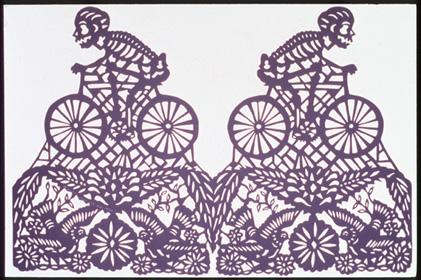Papel Picado / Cut Paper Banners
Appropriate for grades: K - 12
Subject areas: History and Social Studies Mathematics Visual and Performing Arts
Papel picado literally means ‘punched’ or ‘perforated’ paper. This traditional cut paper folk art is found throughout Mexico and the former colonies of Spain as well as in the folk traditions of many other countries. In Mexico the art has reached a pinnacle of expression and is present at every major holiday in the form of brightly colored strings of cut tissue paper banners strung under the portals of homes and across the narrow streets of colonial villages. Banners of papel picado are charming announcements bearing messages on topics both sacred and profane. The materials of papel picado are ephemeral. Papel picado banners will disintegrate in less than a month if left out in the sun, wind and rain. Therefore few historic examples of this folk art exist. The Mexican art of paper-cutting is a marvelous synthesis of European, Asian, and Pre-Columbian artistic traditions. Spanish Language Version
Teaching / Learning Goals:
Teachers and students will …
Objectives
- Learn about The history and development of the papel picado tradition in Mexico and its origins in Pre-Columbian, Asian and European cut paper traditions. They will understand how their papel picado banners relate to the older traditions (historical and cultural understanding).
- Learn about the materials and designs used to create papel picado banners and methods of construction (perceiving, analyzing, and responding).
- Design and create Mexican papel picado banners and develop solutions to design problems through the use of line, form, combinations of color, symmetry, repetition and variation of pattern (creating and performing).
